|
1.
CENTRAL/ WEST AFRICA
West African prices remain flat
The backup in log stocks, due to the recent severe curtailment in shipments to China, has
impacted production forests. Although the major species affected is okume, other lesser volume secondary timber is not being
accepted for shipment. Some producers have ceased logging many species including andoung, faro
dabema, and okan, until the situation is clearer and normal buying is resumed. Sellers are looking hard for alternative
markets that have been neglected over the past few years. Morocco, Turkey and some European countries are being
targeted, but are subject to tough price negotiations.
The notable decline in demand from Spain in the past year (TTM 12:10) is of concern to West
African producers and the sudden end to Spain's building boom will likely have a
negative impact on log and lumber consumption in the medium-term. China and India were active in the Spanish
market, and are now a factor to be reckoned with.
Producers with plywood and sawmill facilities are stepping up production to assist in using logs
previously earmarked for export. As a result, prices for downstream products have held firm.
However, with the European vacation period about to start in July, some producers are
uneasy about the current market and are fearful of a dramatic fall in demand.
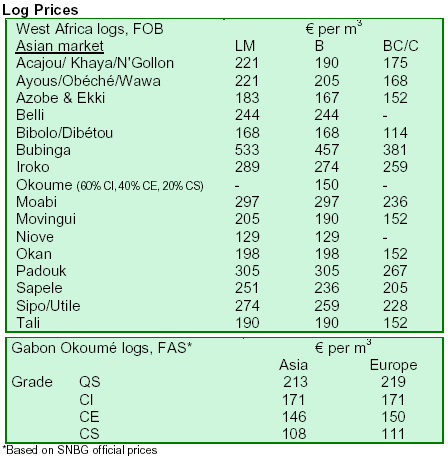
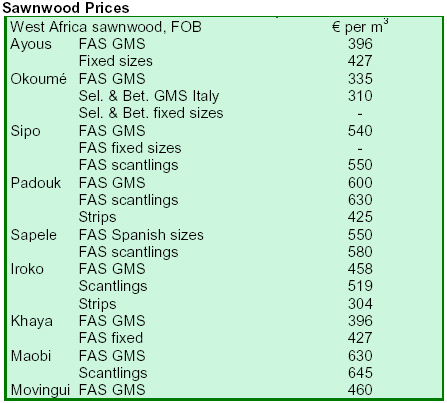
2. GHANA
Ghana*s approves more contracts in first quarter
The Contract Section of the Forestry Commission*s (FC) Timber Industry Development Division
(TIDD) processed and approved a total contract volume of 188,867 m3 during the first quarter of
2007. This represented a 40.92% rise compared to the previous quarter (Oct-Dec.2006).
Plywood contracts alone during the quarter under review, recorded at 88,151 m3, represented 46.67% of the overall
total contracts processed and approved. Plywood was the leading product for contracts
during the quarter under review, moving lumber to second place.
The number of furniture parts approved during the quarter fell 36.90% from the previous quarter. A
total of 26,430 pieces of furniture parts were approved in 2007 under the quarter under review,
compared to 41,884 pieces processed and approved during the last quarter of 2006.
The reduction was attributed to the high orders placed by buyers during the previous quarter.
With the exception of mouldings and processed lumber, which dropped sharply by 40.67% to a low of 3,994 m3,
almost all wood products recorded increases in volume. Volumes of finger-jointed,
parquet flooring, dowels, rotary and sliced veneer increased by 101.15%, 65.28%, 75.06%,
20.85%, and 2.0%, respectively compared with previous quarter figures. Teak poles, logs, and billets
increased by 54.24% from the previous quarter to 12,333 m3 during the quarter under review.
Prices for Ghanaian logs mixed during first quarter
Prices had been firm during the January-March 2007. With the exception of odum, for which buyers were
finding difficult to meet TIDD Guiding Selling Prices (GSP), prices for sapele, makore, utile and mahogany
(Ivorensis) increased.
Prices rose between EUR25 and EUR55 per cubic meter for kiln dried sapele, makore and utile
lumber to the European market, depending on the specification. There was an increase of between US$20 and US$40 for kiln
dried mahogany lumber to the United States, the main destination of the product. With the persistent increase in
prices of mahogany, most buyers in Europe had switched to importing edinam. During the last month of the quarter
under review, prices of edinam contracts (kiln dried lumber) for the European market rose as much as EUR98
for random specifications. It was anticipated that more contracts would be submitted for edinam in the second
quarter.
Submission of contracts for mixed redwoods, comprising of edinam, danta, candollei and mahogany
(Grandifolia and Anthotheca), to the Middle East market slowed during the quarter under review.
However, prices of the product rose significantly from an average price of US$340/m3 to
an average of US$370/m3.
For the first time okoume, a traditional species in Cameroon, was exported from Ghana. The
species was imported by Pyramid Veneer Company Limited in Cameroon, manufactured into curl
veneer, and re-exported to Europe at a higher price of EUR12.48/m2, EUR11.93/m2 and
EUR8.10/m2 for Grades One, Two and Three, respectively.
Prices of ceiba rotary veneer continued to increase during the last month of the previous quarter.
The 4.2mm price, which experienced downward trend for most of 2006, improved to an average of $300/m3 from the previous
quarter average of $270/m3.
Ghana*s export permits increase slightly
Two thousand and sixty-one export permits were vetted, processed, approved and issued to
exporters during the first quarter of this year to cover the shipment of various
wood products through the ports of Takoradi and Tema as well as overland exports to neighboring countries. The
corresponding figure of total export permits issued for the previous quarter (2006) was 1,999. This showed a
marginal increase of 3.52% in the number of permits issued for wood products exports during the first quarter of
this year.
Two hundred and twenty one (221) permits were granted to 12 companies to export plywood and lumber by road to
Burkina Faso, Nigeria, Niger and Togo. Companies which were engaged in overland exports included Ghana
Primewood Products Ltd (GAP), John Bitar & CompanyLtd (JCM), Naja David Veneer & Plywood Company Ltd
(NDVP), Samartex Timber & Plywood Company Ltd
(SAX), Bibiani Logging & Lumber Company Ltd (BLLC) and Ayum Forest Products Ltd
(AFPL).
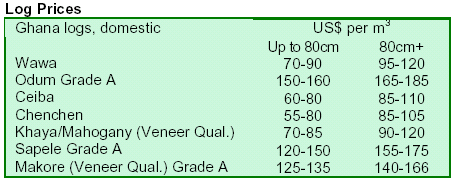
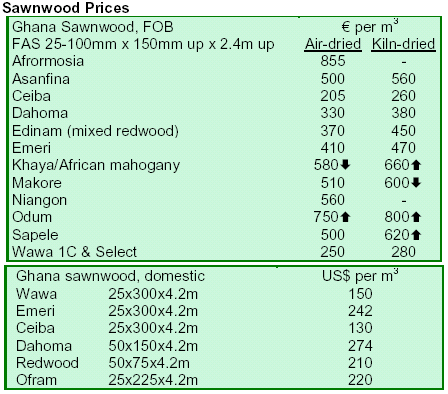
3.
MALAYSIA
Malaysian efforts bring illegal logging cases down
According to the Malaysian Ministry of Plantation Industries and Commodities, there has been a significant
reduction in the number of illegal logging incidents in Malaysia. This is due to a number of ongoing efforts to
curb illegal logging, including through curbing the transboundary movement of illegally traded logs and by enhancing transparency by promoting legally and
sustainably sourced timber.
Malaysia has also embarked on negotiations with the European Union for a Voluntary Partnership Agreement
(VPA), which is part of the EU*s Forest Law Enforcement, Governance and Trade
(FLEGT) scheme. Deputy Minister Datuk Anifah Haji Aman and Malaysian legislators have
also attended the recent G8 Illegal Logging Dialogue, organized by GLOBE International, to show
Malaysia*s commitment to addressing illegal logging. The dialogue was held to discuss and agree on practical policies as well
as actions to address the global problem of illegal logging and poor forest management.
French Buying Mission focused on wood-based products
Business deals worth a total of RM35.2 million are expected to be secured between Malaysian
wood-based companies and clients from France, as a result of the twoday French Buying Mission 2007. Malaysia External
Trade Development Corp (Matrade) Deputy Chief Executive Officer, Wong Lai Sum, said RM5.3 million in
sales have been confirmed so far, and noted that the buying mission would help small and medium scale
enterprises to network and market their products.
Thirteen French businessmen from 11 companies have taken part in a trade mission organized by Matrade and
held one-to-one business meetings with 65 local timberbased companies. A total of 253 business meetings were
arranged, exceeding the initial target of 154. Among the products sourced during the mission were sawn timber,
plywood, wood mouldings, wood floorings and indoor and garden furniture.
France is Malaysia*s fourth largest trading partner among the European Union countries, and
wood-based products are Malaysia*s fifth largest export component. Bernama
indicated that the country's exports of wood products to France amounted to RM104.9 million in 2006. The news
agency also reported that Malaysia exported RM34.3 million worth of wood-based products to
France in the first quarter of this year.
Malaysia expands presence in Middle East markets
Exports of major Malaysian timber products to markets in the Middle East continued to expand, with the oil-rich
Gulf Cooperation Council (GCC) countries accounting for the major share of exports.
The GCC comprises of the United Arab Emirates (UAE), Saudi Arabia, Kuwait, Bahrain, Qatar, and Oman imported
about US$288 million worth of timber products, which accounted for 78.4% of Malaysia's total timber products
exported to the entire Middle East for the January-November 2006 period.
The UAE topped the list for the 2006, importing US$159.2 million worth of timber products, followed by Saudi
Arabia US$59.2 million, Kuwait US$34.1 million, Bahrain US$12.1 million, Qatar US$16.3 million and
Oman US$7.1 million. The two other major Arab markets were Jordan, which imported US$31.5 million worth of
timber products during the 2006 period, and Yemen, which bought US$31.8 million worth of products.
According to Malaysian Timber Council*s (MTC) regional office in Dubai, the current boom in the building
construction and real estate sectors of GCC countries resulted in high demand for
wood-based products and furniture. Total value of projects reached an all-time high
due to a GCC-wide construction boom undertaken by both the public and private sectors, where total active projects
in Bahrain alone are estimated at US$27.43 billion.
Jaya Tiasa to expand plywood production
The publication Wood Based Panels International and The Star newspaper reported that Jaya Tiasa Holds Bhd would
expand its plywood production capacity over the next few years. The company, which held approximately 710,000ha
of timber concessions in Sarawak, planned to invest RM155 million (US$1.5million) in operations, including
on a new plywood production line. The new line was
expected to increase production capacity by at least 5,000 m3 per month. The company was
maintaining a positive outlook on the marketing of its products, as it expected the
higher cost of Russian imports to stifle competition from China.
Malaysia braces for La Nina
Storms from La Nina atmospheric conditions inundated the city of Kuala Lumpur early this month. If effects of La
Nina continue to impact Malaysia during June and July, the country can expect a
repeat of the widespread flooding and the massive destruction that occurred between
December 2006 and January 2007. Timber prices during that period rose and broke all previous records in
Malaysia and Indonesia. However, prices of most Malaysian timber products have remained steady at present.
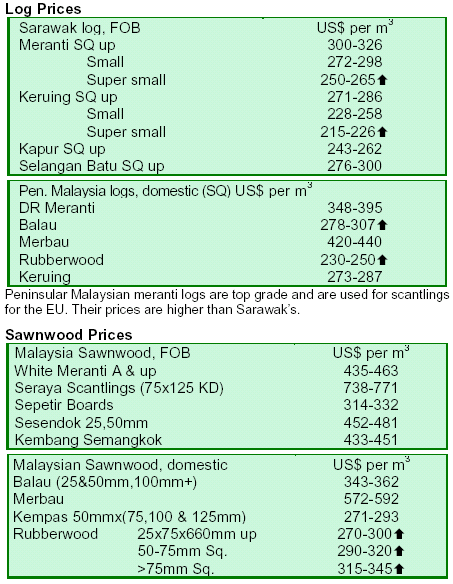
4.
INDONESIA
Forestry minister launches reforestation scheme
Antara news agency of Indonesia reported that Indonesian Forestry Minister MS Kaban distributed one million
※sangon§ young trees to residents in Tanah Datar, West Sumatra, as part of a national reforestation program. The
minister conducted a working visit to the districts of Tanah Datar and 50 Koto, and explained the strategy for
involving the local community in the reforestation scheme. He noted that farmers could plant the sangon seedlings
around their houses, in an effort to alleviate the strain on deforested and arid lands. He added that the government
would plant three million sangon seedlings until the end of 2007, and five million in 2009.
Walhi urges implementation of ※forest cutting interval§
The Indonesian Forum for the Environment (Walhi) is urging the Indonesian federal government and all regional
administrations to implement a ※forest cutting interval§ to protect the country from total deforestation, reported
Bernama.com. Walhi, which had been calling for the interval since 2002, said that 62% of the country*s land
was forest covered, but forest lands were facing increasing pressure due to development and economic expansion. As
a result, the executive director of Walhi, Kalid Syaifullah, suggested a forest cutting interval to alleviate pressure on
forests by initiating a 15 year period during which no new forest concessions would be issued or existing forest concessions extended.
Realizing that the interval would result in wood supply shortages, Walhi suggested the country import more
timber. The group also noted that during the forest cutting interval period, the
performance of forest industries should be checked and efforts made to save forests through
reforestation. The government should also help those people whose livelihood had depended on forest-cutting
activities, Khalid said.
Recent crackdowns on illegal logging had caused hardships to small family or community owned furniture
manufacturers, which depended on forest-cutting activities for their raw materials.
Increasingly, importing countries were turning away from Indonesia and Malaysia as raw
material supply became a major issue, and were turning to Vietnam as an alternative supplier of both
household and office furniture. The countries in Indo-China, e.g. Vietnam, Cambodia and Laos, were expected to overtake
both Malaysia and Indonesia within the next five years as major suppliers of agricultural and timber-based products
to the international markets.
Log stocks stay at low levels
The Japan Lumber Journal reported that factories in Indonesia were keeping log stocks at low
levels, due to frequent rain and lack of smooth operations. Although the number of contracts
showed price increases for 12mm products such as plywood, Japanese demand in general is
weak.
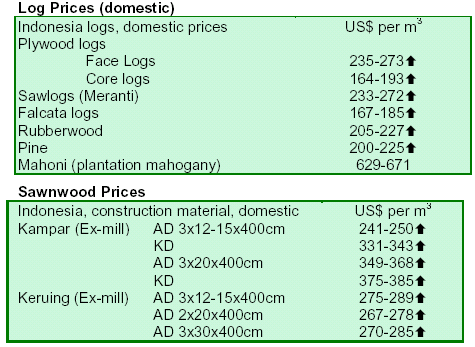
5.
MYANMAR
Demand for teak and gurjan logs remains strong
Although demand for teak logs was strong, the available supply of teak logs were of low grades. Gurjan logs were
also selling well, and would mostly be used for veneer peeling and flooring. On the other hand, most orders for
sawn teak could not be met because of low raw material supply. For pyinkadoe logs, the market was moving
slowly, especially since logs from last season were not in
high demand.
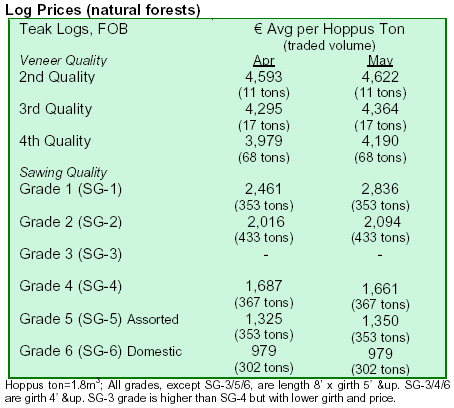
The pyinkado log market remained sluggish while the
market for gurjan logs continued to be firm.

6. BRAZIL
Impacts of forest law to be felt in 2007
Brazil has extended its forest concession grants to be valid for a 40-year period without any limit on the total area
under concession. Companies interested in bidding for concessions can do so on the basis of a technical proposal
and a bidding price.
The Brazilian Forest Service confirmed that the first concessions will be granted in the second half of 2007.
Financial resources collected during the concession period will be under the supervision of the Brazilian Institute of
the Environment and the Natural Renewable Resources (IBAMA) and the State and Municipal Environmental
Secretariats. The financial resources will be expended to control forest operations and re-structure conservation
units.
Brazil*s Law 11,284, which was approved in March 2006, allows the use of public forests as
conservation units, community management and forest concessions for private companies. The
Brazilian Forest Service has recently submitted to the National Congress the first report on
public forest management, as required by law.
Forests cover 56% of Brazil, or about 477 million hectares, according to the Ministry of the
Environment. According to the ministry, the production and legal trade in forest products generate over 3% of GDP, 2 million jobs
(direct and indirect), and more than 8% of exports.
Furniture companies seek greater market participation
The Union of Furniture Industries of the state of Mato Grosso (Sindim車vel-MT) aims to increase its participation
in the domestic furniture market from 20% to 40% in the next five years.
The sector prioritises increasing sales in the Northern region of Brazil, especially in the states of Rondonia, Acre
and Amazonia. About 40 small and medium每sized companies of the state will attend Confortex 2007 and
other business meetings in mid-June. The objective of the meetings is to promote discussion between companies who
sell and buy forest products and of securing new markets for their products.
Several national groups will attend the upcoming business meetings, including one of the largest architecture,
furniture and decoration groups and other smaller entrepreneurial groups from Mato Grosso. According to
Sindim車vel, the events are expected to generate higher sales of furniture for state entrepreneurs.
Brazilwood included in Appendix II of CITES
The TTJ recently reported that Brazilwood has been listed as a protected species under the
Convention on International Trade in Endangered Species (CITES). However, other species such as Spanish cedar and
rosewood have not been listed during the CITES 4-16 June meeting held in The Hague, the Netherlands.
Brazilwood, a Brazilian hardwood, is used for high-end furniture and musical instruments. The new listing will control felling of
Brazilwood, although the use of the species will continue.
Weak USD affects wood product exports
The continuous depreciation of the USD against the Brazilian Real (BRL) has strongly affected the sawnwood
segment in Brazil. From January 2006 until early June 2007, the BRL has appreciated a total of 18.4%. As a
result, exports of solidwood have fallen from 2.3 million/ton in the first third of 2005 to 1.8 million in the same
period of 2007, according to the trade balance data of the Ministry of Development, Economy and Trade
(MDIC). Some sub-sectors are able to redirect the production to the domestic market, but, in general, the picture is
discouraging. In the state of Paran芍, plywood plants have reduced production lines and the number of their
employees.
Between January and April 2007, the exported volume of solidwood products fell 4.9%. The
decrease in plywood alone was 23%, sliding from 439,000 to 337,000/ton. In relation to the same period for 2005, the reduction was
37.7%, with 541,000/ton exported.
The weak USD hit export-oriented production the hardest, mostly of plywood. This has had an impact on the
operation of small and medium-sized companies. For example, three pine plywood units of a major company in
the Southern state of Paran芍 have operated with a smaller number of employees. Despite difficulties faced with the exchange rate, some companies continued to export, partly
due to re-orientation of products and markets.
Celulosa Arauco y Constituci車n expands operations in Brazil
The Chilean panel manufacturer Celulosa Arauco y Constituci車n will expand its industrial operations in
Brazil, by acquiring around 100,000ha of land. This area would include around 35,000ha worth of plantations in
Paran芍 state. The company is seeking a joint venture with Stora Enso Oyj, to acquire more forest land and a sawmill.
Duratex ready to develop its MDF production line
Duratex, a Brazilian wood products supplier, has finalized contracts in order to obtain German machinery necessary
for its new MDF production line, reported EUWID. With the new machinery in place, the plant*s annual production
will be around 500,000 m3, using its two existing MDF facilities and another particleboard facility in Brazil.
Duratex*s capacity to grow by 78% is part of a larger investment initiative unveiled by the company in March
2007. Duratex*s first quarter net turnover increased by 10% and deliveries improved in the domestic market.
Duratex is also looking to acquire 18,500ha of land in Brazil to safeguard its timber supply.
Furniture cluster nets robust growth in Northern Paran芍
The furniture cluster of Northern Paran芍 has become a strategic location of the national furniture sector. There are
576 manufacturing companies that generate 15,350 direct and indirect jobs. The city of Arapongas has the largest
number of companies of the sector, and generates the second largest in revenues across the country.
Between 2000 and 2006, revenues of the companies in the cluster jumped from BRL 480 million to reach over BRL
910 billion, or a growth rate of 91%. With the international business rounds and attendance by importers
of furniture, raw materials and accessories to furniture fairs, the state of Paran芍 is one of the few showing growth
of furniture exports. According to the Brazilian Association of the Furniture Companies (Abim車vel), state
exports increased 15% from USD 91.7 million in 2005 to USD 105.2 million in 2006.
Furniture companies have the capacity to increase their production. The higher exports reflect the trend that
companies are increasing product sale and are seeking to invest in the expansion of their installed capacity,
according to Association of the Manufacturers of Tools and Machines for the Furniture Industry.

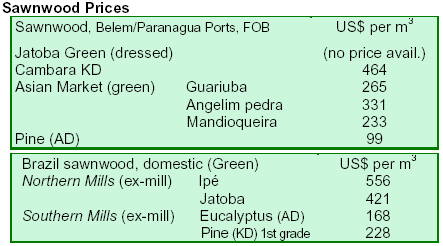
7. PERU
Lumber exports chalk up steady gains in 2007
According to the Peruvian Association of Exporters (ADEX), wood product exports increased 14.32% in the
first quarter of this year, compared with the same period in 2006, mainly due to the increment in sawn wood and
wood flooring exports.
USA, Mexico and China continued as the main destination points for wood products. Compared to the same period of
2006, exports rose 9.75%, 9.4% and 18.8% for USA, Mexico and China, respectively.
Sawn wood of forest species such as cedrela, congona and walnut were the most exported product in the first quarter,
reaching 107% compared to the same period of 2006, followed by wood molding strips for flooring exports.
Conversely, exports of sawnwood from mahogany fell 36.29% in the same period.
South American countries block European action against cedrela
A group of South American countries blocked the European Union*s move to list cedrela as a protected
species under the Convention on International Trade and Endangered Species (CITES). The wood species was
highly valuable for carpenters and cigar boxes makers, mainly due to its natural durability and reddish color.
Peru and other states questioned the EC proposal for Appendix II listing presented at the recent CITES
Conference of the Parties (COP) in The Hague, the Netherlands. During the CITES meeting, Peru argued that
the EU proposal lacked scientific evidence. The blockage of the proposal was a blow to non-governmental
organizations, which insist cedrela is endangered due to felling in national parks and protected areas of Peru and
other countries.
Peru confirms caoba quota
The National Institute of Natural Resources (INRENA) confirmed that Peru will continue to export 13,457 m3 of
mahogany during 2007. This announcement was made in response to media reports that Peru agreed to reduce its
export share of mahogany to 4,983 m3 of sawn wood during the Standing Committee of CITES, which
convened in The Netherlands. Entrepreneurs from the sector, gathered together as ADEX, and suggested that
4,983 m3 only represents the initial share and a new export volume would be progressively approved as forest
management plans were approved and verified, reaching a maximum of 13,475 m3. Critics of the approach to
adjusting export volumes incrementally said it generates legal uncertainty in the sector, and has already resulted in
delayed movement of cargo worth US $10 million in Callao Port.
Rainforest Foundation of Norway slams Peru for endangering indigenous tribes
In a recent report by the Rainforest Foundation of Norway, Peru was criticized for threatening the survival of
indigenous tribes, due to its unsustainable logging of mahogany. The report, ※Illegal Logging and International
Trade in Mahogany (Swietenia macrophylla) from the Peruvian Amazon§, suggests that illegal logging is
occurring in Peruvian national parks and reserves, which are home to indigenous tribes. At the CITES COP in The
Hague, the Rainforest Foundation of Norway and AIDESEP called for Peru to suspend all exports of
mahogany.
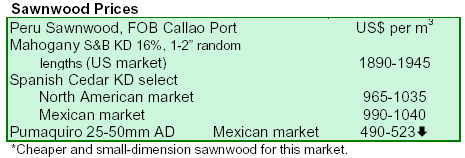
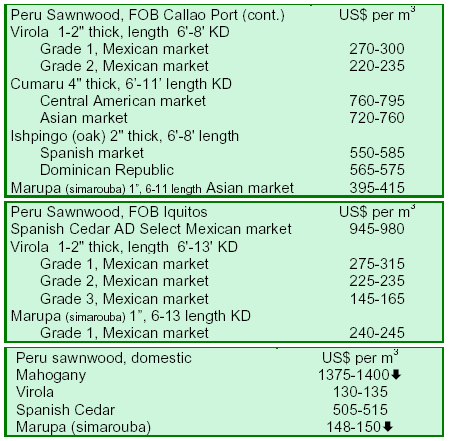
8. MEXICO
Commercial forest producers search for more credit
options
More than one hundred Mexican forest cultivators met in Mexico City this May, in response to a meeting called for
by the National Forest Agency (CONAFOR). There were three thousand projects in Mexico, involving commercial plantations, most of them located in the southeast of the
country and some of them already in the production stage. This situation encouraged those involved with the projects
to actively seek further credit and financing for their projects, fulfill the forest products
demand of the country, and increase the competitiveness of the sector. During the
May meeting, the cultivators expressed their main problems, limitations and doubts regarding forest
plantation investment. By identifying these problems, they suggested improving support mechanisms such as
PROTREE, a program coordinated by the federal government.
9.
BOLIVIA
Santa Cruz and La Paz regions boost timber exports
During the first quarter of 2007, Santa Cruz wood companies exported $15.3 million and La Paz exported
$10.8 million. The figures represent a 23% and 53% rise, respectively, compared to the same period last year. The
main products exported by Santa Cruz companies were furniture (36%), sawn timber (25%), fiber board (11%)
and doors (8%). La Paz*s main exported products were furniture (50%), sawn timber (26%) and doors (20%).
Species such as curupa迆 (Anadenanthera colubrina), which is mainly exported to Brazil and Peru, represent 28% of
total Santa Cruz exports, with 6,000 m3 exported. Other species such as almendrillo (Dipteryx odorata) and quina
quina (Cinchona calisaya NV.) represent 28% and 26%,
respectively, of total La Paz exports in terms of volume. Almendrillo is mainly exported as sawn timber to China,
USA and the Netherlands, and the quina quina as sawn timber to China, Taiwan and Hong Kong.
Interim Forestry Superintendent named
Despite calls from the Chamber of Forestry for the government to follow the procedures stated in its forestry
law for naming an interim Forestry Superintendent, the government named an interim
Superintendent on May 10. According to the forestry law, an interim Superintendent
says that the Interim Forestry Superintendent must be named by the President from a shortlist of three
candidates presented by the Senate. The Chamber believes it is urgent to start following the
forestry law again, since Bolivian success with sustainable forest management was largely
due to institutional stability.

10.
GUYANA
Forestry plays an important role in Guyana*s
development
Minister of Agriculture Robert Persaud recently rejected the view that Guyana*s forests are
over-utilized, as statistics from the Guyana Forestry Commission (GFC) indicate that extraction is slightly above 20 percent of the
acceptable rate. The Minister made the remarks during a meeting with forestry stakeholders on May 27.
The Minister said there is great potential for further advancement of the forestry sector, which is increasingly
becoming a major contributor to the country*s Gross Domestic Product (GDP). In this regard, the government
has been undertaking initiatives to address some of the challenges facing the sector. Critical to the sector*s
sustainable development is the need to ensure compliance with standards and requirements at both the local and
international levels, which must be brought about by changes in forestry practices and principles.
In the upcoming months, the GFC Bill and Act will be taken to Parliament for amendment. In addition, a log
export policy is currently being developed to ensure that:Guyana gets maximum return on all logs exported;
exploitation of endangered species is controlled; and lesser used species are promoted. The Minister noted that the
government would work with investors initially to find a reasonable solution to situations where investors cannot
meet their obligations. However, he stressed that the government would take action once these initial
opportunities were exhausted.
Minister Persaud also presented certificates to 17 persons who recently completed timber grading courses held by
the GFC from 21-27 March 2007. This was done as part of the Commission*s country-wide programme to ensure that
all the necessary timber export requirements are fulfilled.
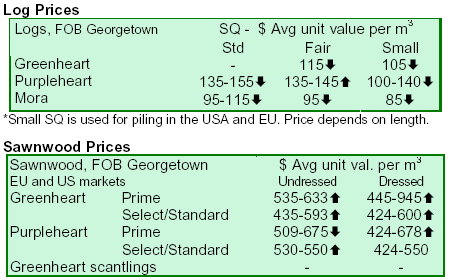
|